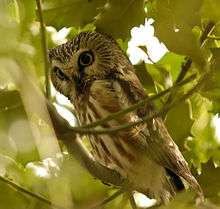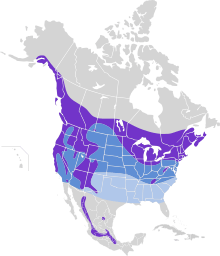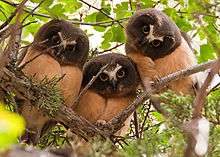Northern saw-whet owl
| Northern saw-whet owl | |
|---|---|
 | |
| Scientific classification | |
| Kingdom: | Animalia |
| Phylum: | Chordata |
| Class: | Aves |
| Order: | Strigiformes |
| Family: | Strigidae |
| Genus: | Aegolius |
| Species: | A. acadicus |
| Binomial name | |
| Aegolius acadicus (Gmelin, 1788) | |
| Subspecies | |
|
Aegolius acadicus acadicus | |
 | |
| Synonyms | |
|
Nyctala acadica | |
The northern saw-whet owl (Aegolius acadicus) is a small owl native to North America.
Description
The scientific description of one of the sub-species of this owl is attributed to the Rev. John Henry Keen who was a missionary in Canada in 1896.[2] Adults are 17–22 cm (6.7–8.7 in) long with a 42–56.3 cm (16.5–22.2 in) wingspan.[3][4] They can weigh from 54 to 151 g (1.9 to 5.3 oz) with an average of around 80 g (2.8 oz),[5][6] making them one of the smallest owls in North America.[7] They are close to the size of an American robin. The northern saw-whet owl has a round, light, white face with brown and cream streaks; they also have a dark beak and yellow eyes. They resemble the short-eared owl, because they also lack ear tufts, but are much smaller. The underparts are pale with dark shaded areas; the upper parts are brown or reddish with white spots. They are quite common, but hard to spot.
Voice
The northern saw-whet owl makes a repeated tooting whistle sound. Some say they sound like a saw being sharpened on a whetstone.[8] They usually make these sounds to find a mate, so they can be heard more often April through June when they are looking for mates. Despite being more common in spring, they do vocalize year round.
Hearing
The northern saw-whet owl has a very sophisticated hearing. It is due to vertically asymmetrical ears and different shape of the ear openings. Because the sound reaches the ears at a different time and is of different intensity, the northern saw-whet owl can very precisely localize its prey. Such accurate sound localization allows it to hunt in a complete darkness by hearing alone.[9][10]
Habitat
Their habitat is coniferous forests, sometimes mixed or deciduous woods, across North America. Most birds nest in coniferous type forests of the North but winter in mixed or deciduous woods. They also love riparian areas because of the abundance of prey there.[11] They live in tree cavities and old nests made by other small raptors. Some are permanent residents, while others may migrate south in winter or move down from higher elevations. Their range covers most of North America including southeastern Alaska, southern Canada, most of the United States and the central mountains in Mexico.
Some have begun to move more southeast in Indiana and neighboring states. Buidin et al. did a study of how far north the northern saw-whet owls breed and they found that they can breed northward to > 50° N, farther than ever recorded before.[12] Their range is quite extensive and they can even breed in the far north where most birds migrate from to breed. They are an adaptive species that can do well in the cold.
Nesting

Northern saw-whet owls lay about four or six white-colored eggs in natural tree cavities or woodpecker holes. The father does the hunting while the mother watches and sits on her eggs. Females can have more than one clutch of eggs each breeding season with different males. Once the offspring in the first nest have developed their feathers the mother will leave the father to care for them and go find another male to reproduce with.[11] This type of mating is sequential polyandry. They compete with boreal owls, starlings and squirrels for nest cavities and their nests may be destroyed or eaten by those creatures as well as nest predators such as martens and corvids. Saw-whet owls of all ages may be predated by any larger species of owl, of which there are at least a dozen that overlap in range. They are also predated by Accipiter hawks, which share with the saw-whet a preference for wooded habitats with dense thickets or brush.[13]
Feeding
These birds wait on a high perch at night and swoop down on prey. They mainly eat small organisms with a strong focus on small mammals in their diet. Swengel and Swengel (1992) reviewed ten studies that found northern saw-whet owls eating almost exclusively mammals (88% to 100%), with most of the mammals being rodents (85% to 99+%). Specifically in their Wisconsin study, the Swengels counted Saw-whets as most often eating deer mice, (Peromyscus; ~ 68% of captured prey), voles, (Microtis pennsylvunicus and M. ochroguster; ~ 16%), and shrews (~ 9%; Blurinu brevicuudu and Sorex cinereus).[14] A similar study by Holt and Leroux (1996) in Montana found saw-whet owls eating more voles (60%) than other mammal species.[15] Engel et al. (2015) also found in the saw-whet owl a strong preference for small mammals (89%), with 55% of prey being two species of voles.
Holt and Leroux compared the eating habits of northern saw-whet owls to northern pygmy owls and found that they prey on different animals for their main food source, with saw-whet's diet 98% small mammals, while for pygmy owls over one-third of their prey was birds. Their study concluded that these owls could adapt depending on the prey and also with the other predators in the areas where they live. Engel et al. (2015) in Chain O'Lakes State Park, Illinois, during the winter of 1987-88, compared Northern Saw-whet to long-eared owls. Engel confirmed the saw-whet owl's strong preference for small mammals. Their diet appeared varied in the winter, and was less tied to one mammal than was the long-earred owl; at times, Northern Saw-whet owls hunted larger prey, such as the meadow vole (M. pennsylvanicus).[16]
Other mammals preyed on occasionally include shrews, squirrels (largely chipmunks and red squirrels), various other mice species, flying squirrels, moles and bats. Also supplementing the diet are small birds, with passerines such as swallows, sparrows, kinglets and chickadees favored. However, larger birds, up to the size of rock pigeon (which are typically about 4 times as heavy as a saw-whet) can even be taken.[13] On the Pacific coast they may also eat crustaceans, frogs and aquatic insects. Like many owls, these birds have excellent hearing and exceptional vision in low light.
References
- ↑ BirdLife International (2012). "Aegolius acadicus". IUCN Red List of Threatened Species. Version 2013.2. International Union for Conservation of Nature. Retrieved 26 November 2013.
- ↑ Beolens, Bo; et al. (2009). The Eponym Dictionary of Mammals p.220. JHU Press. p. 574.
- ↑ (2011).
- ↑ (2011).
- ↑ Sibley, David (2003). The Sibley Field Guide To Birds of Eastern North America. New York: Alfred A. Knopf. p. 229. ISBN 0-679-45120-X.
- ↑ CRC Handbook of Avian Body Masses by John B. Dunning Jr. (Editor). CRC Press (1992), ISBN 978-0-8493-4258-5.
- ↑ Vanner, Michael (2003). The Encyclopedia of North American Birds. New York: Barnes&Noble. p. 192. ISBN 0-7607-3460-7.
- ↑ Bull, John; Farrand Jr., John (1994). National Audubon Society Field Guide to North American Birds. New York: Alfred A. Knopf. p. 555. ISBN 0-679-42852-6.
- ↑ Frost, B.J.; P. J. Baldwin; M. Csizy (1989). "Auditory localization in the northern saw-whet owl, Aegolius acadicus". Canadian Journal of Zoology. 67 (8): 1955–1959. doi:10.1139/z89-279.
- ↑ Gutiérrez-Ibáñez, Cristián; Andrew N. Iwaniuk; Douglas R. Wylie (2011). "Relative Size of Auditory Pathways in Symmetrically and Asymmetrically Eared Owls". Brain Behav Evol. 78: 281–301. doi:10.1159/000330359.
- 1 2 DeLella Benedict, Audrey (2008). The Naturalist's Guide to the Southern Rockies: Colorado, Southern Wyoming, and Northern New Mexico. Golden, Colorado: Fulcrum Publishing. p. 568. ISBN 978-1-55591-535-3.
- ↑ Buidin, Christophe; Rochepault, Yann; Savard, Jean-Pierre L.; Savard, Michel (September 2006). "Breeding range extension of the Northern Saw-whet Owl in Quebec". The Wilson Journal of Ornithology. 118 (3): 411. doi:10.1676/05-092.1.
- 1 2
- ↑ Swengel, Ann B.; Scott R. Swengel (August 1992). "Diet of Northern Saw-whet Owls in southern Wisconsin" (PDF). The Condor. 94 (3): 707. doi:10.2307/1369255. Retrieved 29 November 2011.
- ↑ Holt, Denver W.; Leslie A. Leroux (March 1996). "Diets of Northern Pygmy Owls and Northern Saw-whet owls in West-Central Montana" (PDF). Wilson Bulletin. 108 (1): 123. Retrieved 29 November 2011.
- ↑ Engel, J. I., Dubey, N., & Gnoske, T. P. (2015). Diet comparison of two wintering species of owl in the same stand of trees in Northern Illinois. Transactions of the Illinois State Academy of Science, 108(1), 17+.
External links
| Wikimedia Commons has media related to northern saw-whet owl. |
| Wikispecies has information related to Aegolius acadicus |
- Northern Saw-whet Owl Species Account - Cornell Lab of Ornithology
- Northern Saw-whet Owl - Aegolius acadicus - USGS Patuxent Bird Identification InfoCenter
- "Aegolius acadicus". Integrated Taxonomic Information System. Retrieved 24 February 2009.
- "Northern Saw-whet Owl media". Internet Bird Collection.
- Northern Saw-whet Owl photo gallery at VIREO (Drexel University)
- Interactive range map of Aegolius acadicus at IUCN Red List maps
